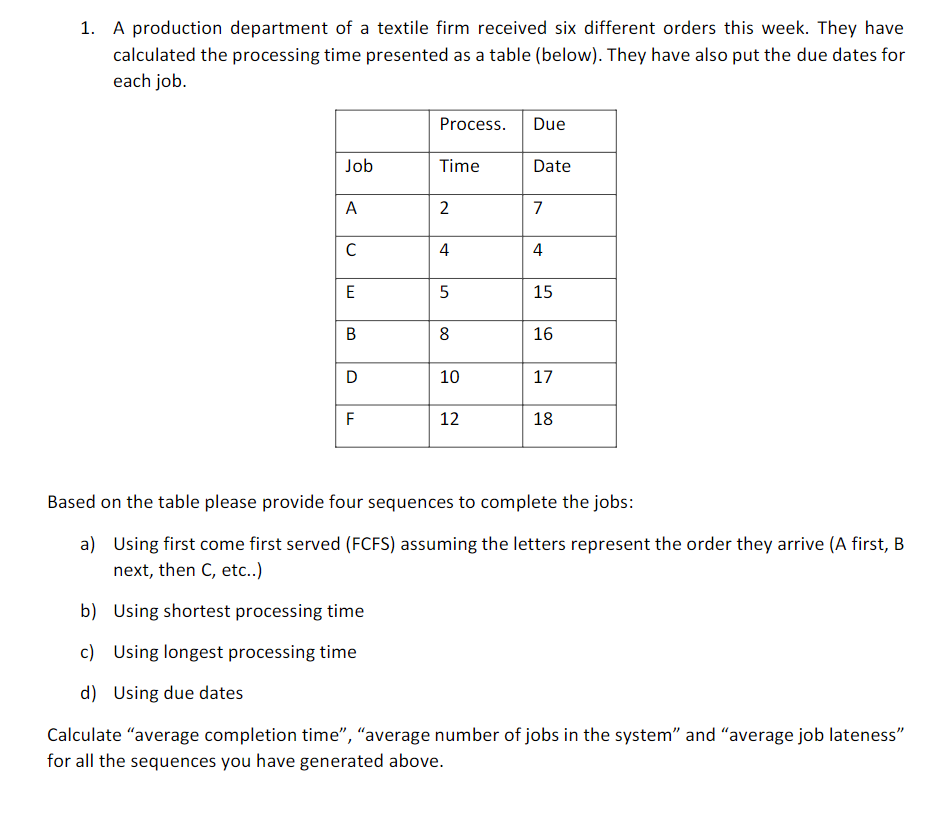1. A production department of a textile firm received six different orders this week. They have calculated the processing time presented as a table (below). They have also put the due dates for each job. Job A C E B D F Process. Time 2 4 5 8 10 12 Due Date 7 4 15 16 17 18 Based on the table please provide four sequences to complete the jobs: a) Using first come first served (FCFS) assuming the letters represent the order they arrive (A first, B next, then C, etc..) b) Using shortest processing time c) Using longest processing time d) Using due dates Calculate "average completion time", "average number of jobs in the system" and "average job lateness" for all the sequences you have generated above.
1. A production department of a textile firm received six different orders this week. They have calculated the processing time presented as a table (below). They have also put the due dates for each job. Job A C E B D F Process. Time 2 4 5 8 10 12 Due Date 7 4 15 16 17 18 Based on the table please provide four sequences to complete the jobs: a) Using first come first served (FCFS) assuming the letters represent the order they arrive (A first, B next, then C, etc..) b) Using shortest processing time c) Using longest processing time d) Using due dates Calculate "average completion time", "average number of jobs in the system" and "average job lateness" for all the sequences you have generated above.
Practical Management Science
6th Edition
ISBN:9781337406659
Author:WINSTON, Wayne L.
Publisher:WINSTON, Wayne L.
Chapter2: Introduction To Spreadsheet Modeling
Section: Chapter Questions
Problem 20P: Julie James is opening a lemonade stand. She believes the fixed cost per week of running the stand...
Related questions
Question

Transcribed Image Text:1. A production department of a textile firm received six different orders this week. They have
calculated the processing time presented as a table (below). They have also put the due dates for
each job.
Job
A
с
E
B
D
F
Process.
Time
2
4
5
8
10
12
Due
Date
7
4
15
16
17
18
Based on the table please provide four sequences to complete the jobs:
a) Using first come first served (FCFS) assuming the letters represent the order they arrive (A first, B
next, then C, etc..)
b) Using shortest processing time
c) Using longest processing time
d) Using due dates
Calculate "average completion time", "average number of jobs in the system" and "average job lateness"
for all the sequences you have generated above.
Expert Solution
This question has been solved!
Explore an expertly crafted, step-by-step solution for a thorough understanding of key concepts.
Step by step
Solved in 3 steps

Recommended textbooks for you

Practical Management Science
Operations Management
ISBN:
9781337406659
Author:
WINSTON, Wayne L.
Publisher:
Cengage,

Operations Management
Operations Management
ISBN:
9781259667473
Author:
William J Stevenson
Publisher:
McGraw-Hill Education

Operations and Supply Chain Management (Mcgraw-hi…
Operations Management
ISBN:
9781259666100
Author:
F. Robert Jacobs, Richard B Chase
Publisher:
McGraw-Hill Education

Practical Management Science
Operations Management
ISBN:
9781337406659
Author:
WINSTON, Wayne L.
Publisher:
Cengage,

Operations Management
Operations Management
ISBN:
9781259667473
Author:
William J Stevenson
Publisher:
McGraw-Hill Education

Operations and Supply Chain Management (Mcgraw-hi…
Operations Management
ISBN:
9781259666100
Author:
F. Robert Jacobs, Richard B Chase
Publisher:
McGraw-Hill Education


Purchasing and Supply Chain Management
Operations Management
ISBN:
9781285869681
Author:
Robert M. Monczka, Robert B. Handfield, Larry C. Giunipero, James L. Patterson
Publisher:
Cengage Learning

Production and Operations Analysis, Seventh Editi…
Operations Management
ISBN:
9781478623069
Author:
Steven Nahmias, Tava Lennon Olsen
Publisher:
Waveland Press, Inc.